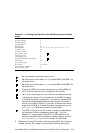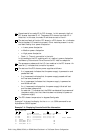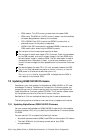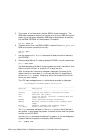
Example 7–4: Displaying Console Serial Bus Information (cont.)
C3 CPU3/SROM V5.0-7 ON
C0 IOR0 ON
C1 IOR1 ON
31 PSM T05.4 (03.24/01:09) T4.0 (07.06) ON SrvSw: NORMAL
31 XSROM T05.4 (03.24/02:10)
C4 CPU0/SROM V5.0-7 ON
C5 CPU1/SROM V5.0-7 ON
C6 CPU2/SROM V5.0-7 ON
C7 CPU3/SROM V5.0-7 ON
32 PSM T05.4 (03.24/01:09) T4.0 (07.06) ON SrvSw: NORMAL
32 XSROM T05.4 (03.24/02:10)
C8 CPU0/SROM V5.0-7 ON
C9 CPU1/SROM V5.0-7 ON
CA CPU2/SROM V5.0-7 ON
CB CPU3/SROM V5.0-7 ON
C8 IOR0 ON
C9 IOR1 ON
33 PSM T05.4 (03.24/01:09) T4.0 (07.06) ON SrvSw: NORMAL
33 XSROM T05.4 (03.24/02:10)
CC CPU0/SROM V5.0-7 ON
CD CPU1/SROM V5.0-7 ON
CE CPU2/SROM V5.0-7 ON
CF CPU3/SROM V5.0-7 ON
40 HPM T05.4 (03.24/01:18) X4.1 (08.18) ON
E0 SCM MASTER T05.4 (03.24/01:21) T4.2 (09.08) ON
E1 SCM SLAVE T05.4 (03.24/01:21) T4.2 (09.08) ON Ineligible
1 The console serial bus (CSB) node ID, or in the case of a QBB, the CPU
number in the QBB. The CSB node address ranges are as follows:
• 10 to 1f: PCI backplane manager (PBM) — The CSB node ID is
based on the PCI drawer node ID setting.
• e0 to e7: System control manager (SCM) — The CSB node ID is also
based on the PCI drawer node ID setting.
• 30 to 37: Power system manager (PSM) — Based on the hard QBB
ID (QBB 0 - 7)
• 40: Hierarchical switch power manager (HPM)
• C0 to CF: In response to the SCM
show csb command, the PSM
provides CSB node addresses for the CPUs and I/O risers even
though they are not on the console serial bus. This enables SCM
commands to be directed at any specific CPU, for instance power
off -cpu c4. The PSM responds to SCM commands and powers
the CPU on or off.
2 The type of CSB node:
• PBM (PCI backplane manager)
• PSM (Power system manager)
• HPM (Hierarchical switch power manager)
Using GS80, GS160, or GS320 Hard Partitions in a TruCluster Server Configuration 7–17


















